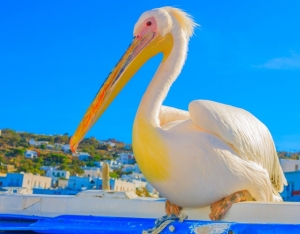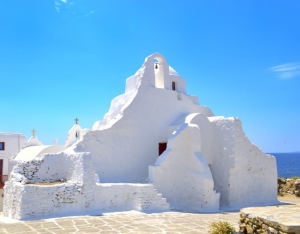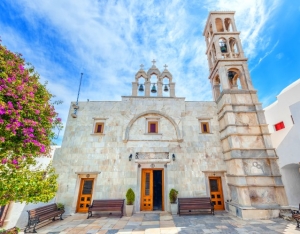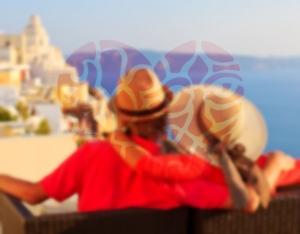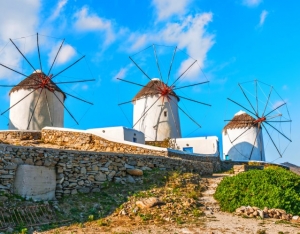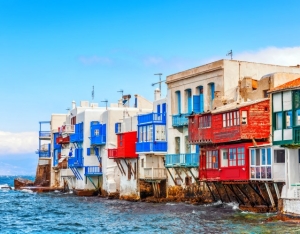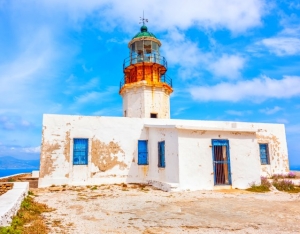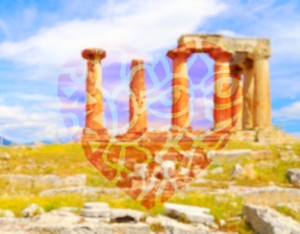Thodoris Bgenopoulos
Mykonos is an island that supports in every possible way the arts and that shows.
First of all, there is the Municipal Art Gallery located in Matogianni right inside the city (Chora), in a building that was previously the residence of the Mykonian painter Mary Inglessi. The Municipal Art Gallery serves as a space of exhibition since 1984 and hosts various exhibitions of painting, sculpture, photography etc.
Mykonos also has an Artistic Station of the of Fine Arts School. This art station serves as host and workspace for promising artists, whose works are also exposed there.
What is more, in Mykonos you will find leading galleries exhibiting works of established and well-promising artists. Some of these are:
- Gallery Minima
- Gallery ΗΜΑΡ (IMAR)
- Gallerie Tsangarakis
- Gallery Skoufa
For those who love live music, in Mykonos you will find your paradise.
During summer, several events take place in the open-air Lakas Theater in Mykonos' Chora. Musical performances also take place in numerous spaces, including the Cultural Center "Grypario" (tel. 22890 – 28636) which is located a km away from Chora, in the way to Ano Mera. An exceptional place in this field is held by the worldwide known Nammos in the cosmopolitan Psarou beach, where events featuring famous greek and international artists (such as Julio Iglesias) take place during summer. Music and Dance events, as well as traditional panigiria are also organized in other parts of the island.
Mykonos of course has its own philharmonic orchestra and choir that give their unique presence in various events on the island.
You can be further informed through ΚΔΕΠΑΜ (KDEPAM: Municipal Cultural Development of Mykonos' public benefit) via tel.22890 - 27190 and 22890 -27791.
One of the first images that come to mind upon hearing the word Mykonos is definitely the pelican. The first report on this beautiful bird was first made in 1958.
It was then that a pelican broke away from his herd and fell exhausted into the sea, next to a Mykonian boat. The fisherman sheltered, fed, nursed the poor bird and brought it in Mykonos. There the pelican immediately loved the island and its inhabitants, but the feelings were reciprocated by the people. They felt at first glance that this gorgeous bird was their own, so they gave him a name.
Petros the Pelican. Since then, Petros has been the beloved mascot not only for the locals, but also the countless visitors that started to land on the island. Several Mykonians considered the pelican a great luck and they still feel the same. The fame of Petros the pelican quickly surpassed the limits of the island and spread throughout the world. The first pelican died in 1985, and today in the island live 3-4 pelicans. Although the locals have given them other names, visitors still call all of them 'Petros'.
Paraportiani is probably one of the most prominent churches in the world. The church got its name because it is located near the "paraporti '', ie the small gate of the medieval castle's wall. Basically it is a complex of five churches, with the four forming the basis and the fifth on top as a sort of dome. The four churches that constitue its basis are St. Eustatius, which is the center of the cluster, Saints Anargyroi, St. Sozon and St. Anastasia. Upon them rests the fifth church, which gave its name to the whole building, Panagia Paraportiani. It is said that the original foundation of the first church, that of St Anargyroi, was about the 14th century and the building gradually took the form it has today. With a shape that makes Panagia Paraportiani unique, it is without question one of the most photographed religious monuments.
This historical monastery of Mykonos is located in the region of Ano Mera. The monastery was founded in 1542 in a location where previously was a church dedicated to Virgin Mary. According to one version, the monastery was founded by fugitive monks from Paros. According to tradition, Panagia Tourliani owes its name to an image of important value that was found floating in the sea region of Tourlos. In 1767 the monastery acquired its current form, thanks to the efforts and the renovation of the monk Ignatius Basoula. Visitors of Panagia Tourliani are initially impressed by the marble belfry with its rich embossed decoration and the marble fountain in the courtyard, both fine examples of traditional Cycladic marble. Moving inside the monastery, your attention will be caught by the wooden temple, the pulpit and the Episcopal throne, all three probably created in Florence. Panagia Tourliani is a sight that will undoubtedly reward you.
What you hear is what you get. Three water wells almost in the center of the town, from which the whole Chora was supplied with water up to 1956. There are different traditions on the verge of myth and legend, according to which if someone drinks water from all three wells he will fall madly in love with Mykonos, or according to another version he will experience a great love (could it be Mykonos again?)
In the region of the Three Wells, one can also find the Aegean Maritime Museum and the House of Lena.
The impressive windmills, known as Kato Myloi (Lower Mills), are located on a small hill, southeast of Chora, between Little Venice and Niohori.
Constructed around 1700, only seven survive today. Initially, 10 where at this point and more than 20 spread across the island.
The mills, utilizing the wind that rarely stopped blowing on the island, used to grind grain and were a great source of income for Mykonos, between the 17th and 19th century. This is because, among other things, they were used in the production of dry type of bread (paksimadi), with which they provided all passing ships.
With the evolution of technology, the mills lose their economic significance but not the special beauty that makes them even today one of the most striking and beautiful parts of Mykonos, Cyclades and the entire Greece.
One of the prominent features of the island is Alefkandra, or as it has become widely known throughout the world, "little Venice". Located in Chora, between Kastro and Scarpa, this is a neighborhood literally built on the beach, strongly reminiscent of the gorgeous Venice of Italy. The houses with their colorful balconies look as if hanging over the sea and when the sea is rough, the spectacle of the waves crashing onto the houses is really unique. The neighborhood was built in the mid 18th century and was originally a place of residence for wealthy merchants and captains. Here you can enjoy one of the most beautiful sunsets on the island.
Faros Armenistis (Lighthouse Armenistis) in Mykonos
15 January 2015This charming lighthouse, built in 1891, is located in the northern part of the island. The building's height reaches 19 meters. The construction of the lighthouse was decided after the sinking of the VOLTA steamship, in which all 11 crew members drowned. The original mechanism of the lighthouse (built by Sauter -Lemonier and winning in the International Paris Exhibition) operated until 1983.
Now it is exhibited in the Aegean Maritime Museum. By 1985 the lighthouse Armenistis had a permanent lighthouse keeper, but now is fully automated. You can reach the Armenistis lighthouse by driving, from Agios Stefanos.
These are ruins of two towers dating from the Hellenistic era. The towers, which had a diameter of 3.5 meters, own their name to the upright door of the tower that survives until the present day and consists of 3 large hewn granite stones.
Portes are really close to Platis Gialos and are definitely worth a visit.



